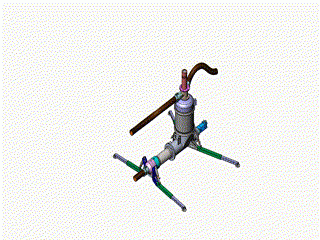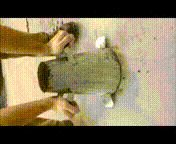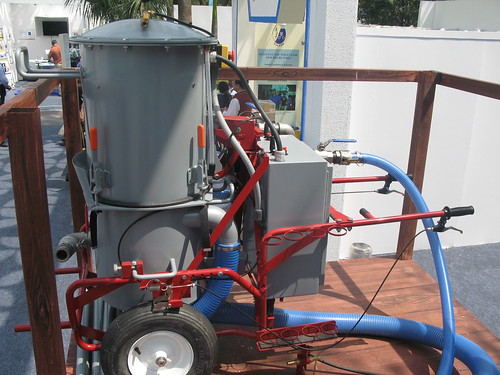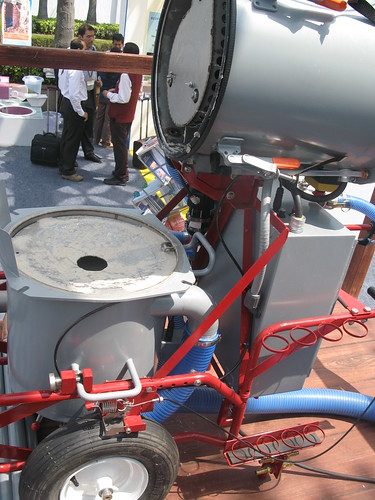- Forum
- categories
- Sanitation systems
- Faecal sludge management (FSM)
- Faecal sludge transport (including emptying of pits and septic tanks, transfer stations)
- Fecal Sludge Omni-Ingestor (FSOI) suite of technologies for fecal sludge emptying and transport (contract by BMGF, USA and Senegal, India, South Africa)
Fecal Sludge Omni-Ingestor (FSOI) suite of technologies for fecal sludge emptying and transport (contract by BMGF, USA and Senegal, India, South Africa)
17.9k views
- jvaneynde
-
 Less
Less- Posts: 7
- Karma: 1
- Likes received: 1
Re: Fecal Sludge Omni-Ingestor (FSOI) suite of technologies for fecal sludge emptying and transport (contract by BMGF, USA and Senegal, India, South Africa)
Fecal Sludge Omni-Ingestor Project update
Start & End Date: 2011 – TBD (to be determined; the contract has been extended to accommodate a changing or growing scope of work)
Type of Funding: Contract
Funding Size: Not applicable as this is a contract and not a grant; contract amounts are not disclosed by the foundation. Funding is currently on-going.
Developing country(ies) where the research will be tested: The Omni-Ingestor will be tested in India, Senegal and South Africa, as well as other locations that are yet to be determined.
Short description of the project: The FSOI Project is developing a number of devices to improve On-site Sanitation.
- FSOI Mechanical Pump will pump waste 50-100 meters, much further than vacuum trucks, enabling it to access 92-97% of the vaults in unplanned settlements in Africa. The pump is also capable of pumping waste from wet and dry vaults*, (0-40% TS) permitting mechanical emptying of nearly all sludge types. The pump is a stand-alone system that can fill a variety of sludge transporters, including vacuum trucks, tank trucks, and trailers. Because it is not attached to a sludge transporter, the pump is free to continuously fill one transport vehicle after another—increasing operational efficiency.
- FSOI Mobile Pre-Processor is used to process sludge from wet vaults (0-5% TS). It will remove debris and grit from incoming sludge and render it safe for on-site disposal. The sludge will be thickened and the liquid effluent will be clarified, deodorized, and sanitized so that it can be discharged onsite. Only thickened sludge will be transported to a disposal site, significantly reducing transportation costs.
- Two inexpensive oxidant generators. One oxidant is NaCl; the system uses water and easily sourced salt (table salt is fine) and produces batches of chlorine large enough to treat all of the heavies (grit, glass, metal) removed from influent. The other system generates inexpensive ferrate that can be used to treat the effluent from a sludge thickener.
* Beaumont has been using the term vaults because the use of pits implies latrine pits. We also do not use tanks because it implies septic tanks. We feel vault is more generic. Also, pits implies dry material and septic tanks implies wet material but this is not always the case. So Beaumont uses dry vaults and wet vaults, independent of the construction technique.
Goal(s) of the Project: Empty wet and dry vaults, Access vaults that couldn’t be reached before, Pump all contents not just the liquid fraction, Cut emptying costs
Current state of affairs: Two prototypes of the FSOI Mechanical Pump have been domestically field tested (i.e. in Puyallup, WA, USA), and the third and final prototype pump will begin domestic field tests at the end of February 2015. Domestic testing of the pumps involves pumping out septic tanks, latrine pits, and even some grease pits. Treatment technology is expected to enter field-testing in India, Senegal & South Africa in Q2 of 2015. The technology(ies) to be tested in the field have not been identified yes; the decision will be made after the third and final prototype has been domestically tested.
One of the oxidant generators is intended for use on the OI. The other will be based in a facility and used to fill canisters of oxidant for use on the OI. The oxidant generators will not be available until there is a Mobile Pre-Processor. The companies developing the technology may choose to take derived products to market independently. Due to the fact that this work is contracted, and private IP is involved, the processes the distribution plans cannot be shared at this time.
Biggest successes so far: Several unique pumping technologies have been developed as well as two inexpensive oxidant generators.
Main challenges / frustration: Development of a reliable polymer dosing system and a commercially viable sludge thickener. Generally, dosing of polymer is done on a large scale (dosing 1000’s of gallons of waste water) based on the results of lab tests. The OI needs to pump and treat waste in real-time, or near-real time. That means we need a system that can adapt to the changing physical and chemical properties of the influent as the vault is pumped and between vaults.
Lead Organizatin: Beaumont is acting as the Project Manager, and is also developing some of the associated technology for the project.
Research and implementation partners include:
- AGI Engineering – AGI Engineering, Inc. specializes in the design, construction and testing of custom, specialized tank cleaning, pumping and automated manufacturing equipment (Stockton, CA, USA) (www.agieng.com/).
- Beaumont – Beaumont provides industrial design, mechanical engineering, systems architecture, and project management services (Honolulu, HI, USA) (beaumontdesign.com/).
- DCI Automation – DCI Engineering has become the product development and prototyping arm of Columbia Tech (Worcester, MA, USA) (www.dciautomation.com/).
- Synapse Product Development – Synapse Product Development is a product development, product design, and technology development consultancy company (Seattle, WA, USA) (www.synapse.com/home-page).
- FloHawks Plumbing & Septic – FloHawks provides residential and commercial plumbing and septic services (Puyallup, WA, USA) (www.flohawks.com/).
- Cascade Designs, Inc, - (Seattle, WA, USA) (www.cascadedesigns.com/)
- Ferrate Treatment Technologies – FTT aims “to be the global provider of water treatment solutions based on Ferrate, the most powerful, multi-use, and environmentally friendly water treatment chemistry known. FTT will commercialize Ferrate to purify water, improve human health and clean up industrial contamination worldwide”. (Orlando, FL, USA) (www.ferratetreatment.com/).
If you would like more information about this project, please visit FSMtech.org.
Independent Consultant
E: This email address is being protected from spambots. You need JavaScript enabled to view it.
P: +1 (425) 765-2410
Please Log in to join the conversation.
You need to login to replyRe: The Fecal Sludge Omni-Ingestor (FSOI) suite of technologies (several companies, USA)
President/Founder of Beaumont
Attachments:
-
 IndiaSLAni...Logo.gif
(Filesize: 20KB)
IndiaSLAni...Logo.gif
(Filesize: 20KB)
Please Log in to join the conversation.
You need to login to replyRe: The Fecal Sludge Omni-Ingestor (FSOI) suite of technologies (several companies, USA)
The Manual Pump is a low cost pump designed for use by manual emptiers with the main objective of allowing them to empty vaults in a more safe and sanitary manner. It was designed for emptying relatively shallow vaults (2 meters) and pump material with a solids content below 10%. As of yet, I don’t have any empirical data about the shear strength of the simulants that have been used but we have mixed up some pretty thick material. I’ve used the pump with actual septage and can pump at 1 liter/sec easily and at 2 liters/sec with some effort. I’m working on a third generation design and expect to have prototypes in the field in about 4 months.
There are 3 different powered pumping solutions being developed. The one demonstrated in India was designed for emptying septic tanks having a TS below 5%. The shear strength of what has been pumped hasn’t been measured but I think we can pry an estimate from Jamie Radford, who is consulting on the project. It can handle septage that is loaded with debris and grit, and can pump it greater distances than most vacuum trucks. The other two pumps are still being designed or manufactured. Both of them can handle material with a TS of 40%. All three can pump at a rate of at least 3 liters/sec.
The three powered-pumps are all entering intensive domestic field-testing in the next few months. They’ll be independently tested by waste management companies that will use them in their day-to-day businesses of emptying residential, commercial, and government septic tanks and out-houses. Following the successful completion of that testing, one of the pumps will move on to foreign field-testing.
Over the last 2 years, many simulants have been used and we’re still refining the recipes. They’ve varied from the simple (bentonite and water, kaolin clay and water) to the complex and costly. But, for the most part, they have been homogenous mixtures, not weak mixtures with TS values exaggerated by adding gravel or dense material. We also have a long list of extraneous matter that can be added to the sludge to make it extra challenging. Within the next 8 weeks, when the ingredients are settled upon and the instructions for producing them and testing them are finalized, we’ll be sharing the information online.
One of our directives was to develop a pumping system that would make emptying the vast majority of the vaults in the developing world possible. This presents two big challenges. First, the pump must be capable of pumping a wide range of sludges. Shear strength, density, plasticity, stickiness, debris types and quantities, and grit types and volumes are just some of the factors to account for. Second, the pumping systems need to reach the vaults. GIS data and custom algorithms were used to determine the hose length needed to reach 90% of the pits in African urban settlements and the results were verified with ground surveys. It was determined that about 92% of the vaults in Africa could be reached from the nearest drivable road by a 50 meter hose. The survey work also drove the design requirements. Path widths, roughness, turn radii, incline, road types, road-to-vault distances, weather conditions, soil type, door width, ceiling height, access hole size, hose types, and vault dimensions are a few of the variables considered.
This is an exciting time for those of us working on the Omni-Ingestor project as we’re entering the field-testing phase, getting closer to having a commercial product, and the work is getting more public exposure. We’ve been pretty quiet up till now and RTTF India was the first time we really publicly shared information about the equipment being developed. It was fun talk to people about the OI and answer their questions. So thanks for your questions and I’m happy to answer any more you might have.
Andrew
Andrew Whitesell, USA
p.s. I've attached a short video showing one of the simulants.
President/Founder of Beaumont
Attachments:
-
 Milorganit...Test.gif
(Filesize: 736KB)
Milorganit...Test.gif
(Filesize: 736KB)
Please Log in to join the conversation.
You need to login to reply- RadfordJT
-

- Civil engineer with a particular interest in sanitation and faecal sludge management.
Less- Posts: 10
- Karma: 3
- Likes received: 8
Re: The Fecal Sludge Omni-Ingestor (FSOI) suite of technologies (several companies, USA)
I'll start with a very brief self-introduction as despite being a member of SuSanA for years I've not been particularly active - now changing! I'm a civil engineer, but my masters thesis was on "Characterisation and fluidisation of pit latrine sludge" and I have continued in that vein over the last couple of years, firstly developing the portable penetrometer, and most recently developing safe synthetic simulants for the Omni-Ingestor project to use in testing its pumping system. I’ll let Andrew respond on the FSOI project before adding my thoughts and further details on the (physical) strength requirements in the performance spec, as well as the simulants we've produced.
I totally agree with the need for standardisation and to be more quantitative and comprehensive – nicely put Francis! To that end, we are currently developing a project with the University of Cambridge to benchmark the performance of different faecal sludge pumps (mostly manual or small mechanised) with the aim of mapping their “technical performance” (ie limiting characteristics of sludge that they can pump) and evaluating them against a set of performance metrics – eg capital cost, whole life cost/m3 pumped, average flow rate for a 1m3 pit, local supply chains/manufacturing capability. The plan is to conduct lab tests using the pumping simulant we have developed for the FSOI project, with and without debris/solid waste, so we can control and measure the strength of the material used for testing. Ideally this will also be complemented by field testing the actual performance of larger mechanised systems, such as the FSOI, using the penetrometer. The intention is to develop a quantitative and objective analysis of the various different systems available to identify the most promising systems for technology developers and entrepreneurs alike to invest time/money in.
Any offers to loan/donate/sell us pumps, and/or contributions to cover the costs of the project would be warmly received!
For further details on the penetrometer, please see this separate post (forum.susana.org/forum/categories/99-fae...atrine-contents#8362).
Please Log in to join the conversation.
You need to login to replyRe: The Fecal Sludge Omni-Ingestor (FSOI) suite of technologies (several companies, USA)
However, some form of "standardization" would help promote understanding these differences. There was a nice MS thesis on sludge characterization in Kenya by Damian Seal of Cranfield University in 2012. That and Jamie Radford's work are big steps in the right direction. It would be nice to have a concerted effort around the world to be more quantitative and comprehensive in sludge characterization.
Professor/TED Fellow
Please Log in to join the conversation.
You need to login to reply- Elisabeth
-
Topic Author
- User is blocked
- Freelance consultant since 2012
Less- Posts: 3372
- Karma: 54
- Likes received: 932
Fecal Sludge Omni-Ingestor (FSOI) suite of technologies for fecal sludge emptying and transport (contract by BMGF, USA and Senegal, India, South Africa)
I am providing information below about a prototype faecal sludge "omni-ingestor" that I saw at the Reinvent the Toilet Fair in Delhi in March.
This project has not been described on the forum to date; it is not a grant but the work is being carried out under a contract agreement with the BMGF. So the companies developing this piece of equipment are in fact "contractors", not "grantees".
Here is the interview I did with Andrew Whitesell, the project manager:
In this second video, Andrew explains their two exhibits (one manually operated unit for faecal sludge pumping and one motorised one):
And here is a professional (promotional) video they got done:
www.dropbox.com/s/nyjojg7a6lwbpv1/CCI%20...C%20with%20video.wmv
We also have a photo set on Flickr:
www.flickr.com/photos/gtzecosan/sets/72157644229002652
Two example photos from this set:


Some documents about the omni-ingestor in the SuSanA library (from 2012):
www.susana.org/library?search=omni
The omni-ingestor device was also mentioned in the presentation by Mbaye from Senegal where there are plans to use it in future, see here on the forum:
forum.susana.org/forum/categories/97-ena...tion-processing#7354
And I have copied the following information from the Technical Guides (susana.org/lang-en/library/library?view=...eitem&type=2&id=2001), page 45:
The Fecal Sludge Omni-Ingestor (FSOI) suite of technologies
includes pumping, debris
extraction, heavies extraction,
sludge thickening, and
disinfection sub-systems. The
system can be configured to
meet the needs of the vault
emptying business.
The FSOI will increase the vault pumping capabilities of
emptiers (access, effectiveness), reduce their operating
expenses, and improve financial and environmental
sustainability of their businesses. It will permit more
households to rely on mechanical vault emptying, reduce
reliance on unsanitary vault emptying practices, and
reduce the amount of infectious human waste released
into the environment.
The Pumping System of the FSOI will enable emptiers
to pump waste from vaults 50 to 100 meters from the
roadside, giving them access to over 92% of the vaults
in peri-urban spaces. The pumping system will also be
capable of emptying the majority of the contents of both
wet and dry vaults.
The Mobile Pre-Processing (MPP) technology will enable
emptiers to reduce the material transported to waste
treatment plants. The Debris Extraction sub-system
will extract trash from the waste stream, rinse the trash
and disinfect it so that it may be properly disposed of.
The Heavies Extraction sub-system will extract sand,
grit, glass, and metal from the waste stream then rinse
and disinfect the material to make it safe for proper
disposal.
Finally, a Sludge Thickening sub-system will
reduce the water content of the sludge thereby reducing
the volume of material that must be transported to
a waste treatment plant. The MPP is currently under
development and will not be presented at the Delhi Fair.
Improved pumping will widen the market for emptying
services. Reducing the volume of material transported to
WTP’s means lower fuel expenses and more time spent
emptying pits.
FSOI Development Firms: AGI Engineering, Beaumont
Design, DCI Automation, and Synapse Product Development
If you have questions, please put them here. I will encourage Andrew to answer on the forum.
What do you think of the statements made in these two videos?
Francis, who also works on faecal sludge pumping *, voiced the following concerns in an e-mail to me:
Ok, so based on the videos, Omni-Ingestor is saying:
1) the manual pump can take up to 10% solids at 1-2 liters per second
2) the mechanical system can take 5% solids at 5 gal/min
3) something else can do up to 40% ? It's not really clear to me what they mean by that - which one - the big truck?
This is the problem with %solids at the criterion - it doesn't take in to account the strength of the sludge, measured in Pa by a penetrometer. If you put in a few small stones, the % solids can be very high, but the sludge strength is the same as water for the most part. Our bentonite simulant is only 10-12% solids, but the sludge strength is 150 Pa near the middle, and 300 Pa near the bottom. So I know that their manual pump cannot pump as low as 150 Pa.
I need to see the study that claims they can empty 92% of all the pits in Africa.
There is a need to standardize testing - this is something I will explain in the webinar.
Regards,
Elisabeth
* If you are interested in his work, please join us for his presentation at the webinar next Tuesday, 29 April:
forum.susana.org/forum/categories/99-fae...mit=12&start=12#8237
Freelance consultant on environmental and climate projects
Please Log in to join the conversation.
You need to login to reply- Forum
- categories
- Sanitation systems
- Faecal sludge management (FSM)
- Faecal sludge transport (including emptying of pits and septic tanks, transfer stations)
- Fecal Sludge Omni-Ingestor (FSOI) suite of technologies for fecal sludge emptying and transport (contract by BMGF, USA and Senegal, India, South Africa)







